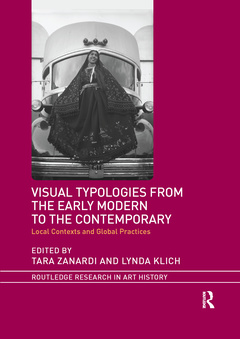Visual Typologies from the Early Modern to the Contemporary Local Contexts and Global Practices Routledge Research in Art History Series
Coordonnateurs : Zanardi Tara, Klich Lynda

Visual Typologies from the Early Modern to the Contemporary investigates the pictorial representation of types from the sixteenth to the twenty- first century. Originating in longstanding visual traditions, including street crier prints and costume albums, these images share certain conventions as they seek to convey knowledge about different peoples. The genre of the type became widespread in the early modern period, developing into a global language of identity. The chapters explore diverse pictorial representations of types, customs, and dress in numerous media, including paintings, prints, postcards, photographs, and garments. Together, they reveal that the activation of typological strategies, including seriality, repetition, appropriation, and subversion has produced a universal and dynamic pictorial language. Typological images highlight the tensions between the local and the international, the specific and the communal, and similarity and difference inherent in the construction of identity. The first full- length study to treat these images as a broader genre, Visual Typologies gives voice to a marginalized form of representation. Together, the chapters debunk the classification of such images as unmediated and authentic representations, offering fresh methodological frameworks to consider their meanings locally and globally, and establishing common ground about the operations of objects that sought to shape, embody, or challenge individual and collective identities.
Table of Contents: Contributors; Introduction to Visual Typologies from the Early Modern to the Contemporary: Local Contexts and Global Practices, Tara Zanardi and Lynda Klich; Repeating, Borrowing, and Serializing the Type; Fashion, Nation and Morality in English Allegorical Costume Prints, c. 1620-40, Heather A. Hughes; "Bodies of Work in the ancien régime: the Costumes Grotesques by Nicolas I de Larmessin", Sarah Buck; The Color of the Orient: On Ottoman Costume Albums, European Print Culture, and Cross-Cultural Exchange, Elisabeth Fraser; On and off the Tram: Contemporary Types and Customs in Madrid’s Illustrated and Satirical Press (1874-1898), Vanesa Rodríguez-Galindo; Staging Place; Venice: City of Fashion and Power in Giacomo Franco’s Habiti d’huomini et donnevenetiane (ca.1610), Eugenia Paulicelli; Costuming the Empire: A Study on the Production of Tributary Paintings at the Qianlong Court in Eighteenth-Century China, Yu-chih Lai; Enrique Díaz’s Parade of Progress: Toward a Streamlined Mexican Future, Denise Birkhofer; Performing the Documentary; "True Types of the London Poor": Street Life in London’s Transitional Typology, Emily Kathryn Morgan; The Myth of the Baiana in Nineteenth-Century Portrait Photography, Maya Jiménez; Circulating lo mexicano in Mauricio Yáñez’s Postcards, Lynda Klich; It is written in their faces: Seri women and facial painting in photography, Deborah Dorotinsky; The Materials of Typology; Fashioning a Nation. Military dress in Peruvian Independence, 1821-1822, Natalia Majluf; From Global Traveler to Costumbrista Motif: The Mantón de Manila and the Appropriation of the Exotic, Tara Zanardi; Cloth, Clothing, and Colonial Power: France and West Africa at the Expositions , Victoria L. Rovine; Against "Fashion-Time:" Bernhard Willhelm, Regional Folk Dress and the Contemporary, Charlene K. Lau; Unmasking Stereotypes; Ambassadors à la turc: Assimilation and Dissimulation in Eighteenth-Century Images of French-Ottoman Diplomacy, Ashley Bruckbauer; The Transmediterranean Routes of Fashion: Between Material Expression and Artistic Representation, Leyla Belkaïd-Neri; Julio Galán and the Type: Fashioning a ‘Border’ Aesthetic, Teresa Eckmann
Tara Zanardi is Associate Professor of Art History, Hunter College, CUNY, USA.
Lynda Klich is Assistant Professor of Art History, Hunter College, CUNY, USA.
Date de parution : 09-2021
17.4x24.6 cm
Date de parution : 07-2018
17.4x24.6 cm
Thèmes de Visual Typologies from the Early Modern to the Contemporary :
Mots-clés :
Ethnologisches Museum; Brown Military Collection; costumbrismo; China Poblana; costume; Costume Books; twenty-first century; Costume Prints; twentieth century; Costume Albums; nineteenth century; Salvador De Bahia; eighteenth century; Visual Typologies; seventeenth century; Ottoman Costume; sixteenth century; Archivo General De La; art history; Afro-Brazilian Women; objects; Folkloric Dress; fashion; Mexican Types; dress; Potent Disseminator; geography; Mexican Hat Dance; occupation; Museo De Arte De Lima; global; North American Free Trade Agreement; contemporary; Folk Dress; modern; Lo Mexicano; visual culture; LSE Library; representation; Tributary Painting; typology; Typological Imagery; Lynda Klich; Hand Colored Prints; Heather A; Hughes; Beinecke Rare Book; Sarah E; Buck; Marc Ferrez; Elisabeth Fraser; Vanesa Rodríguez-Galindo; Eugenia Paulicelli; Yu-chih Lai; Denise Birkhofer; Emily Kathryn Morgan; Maya Jiménez; Deborah Dorotinsky; Natalia Majluf; Victoria L; Rovine; Charlene K; Lau; Ashley Bruckbauer; Leyla Belkaïd-Neri; Teresa Eckmann



